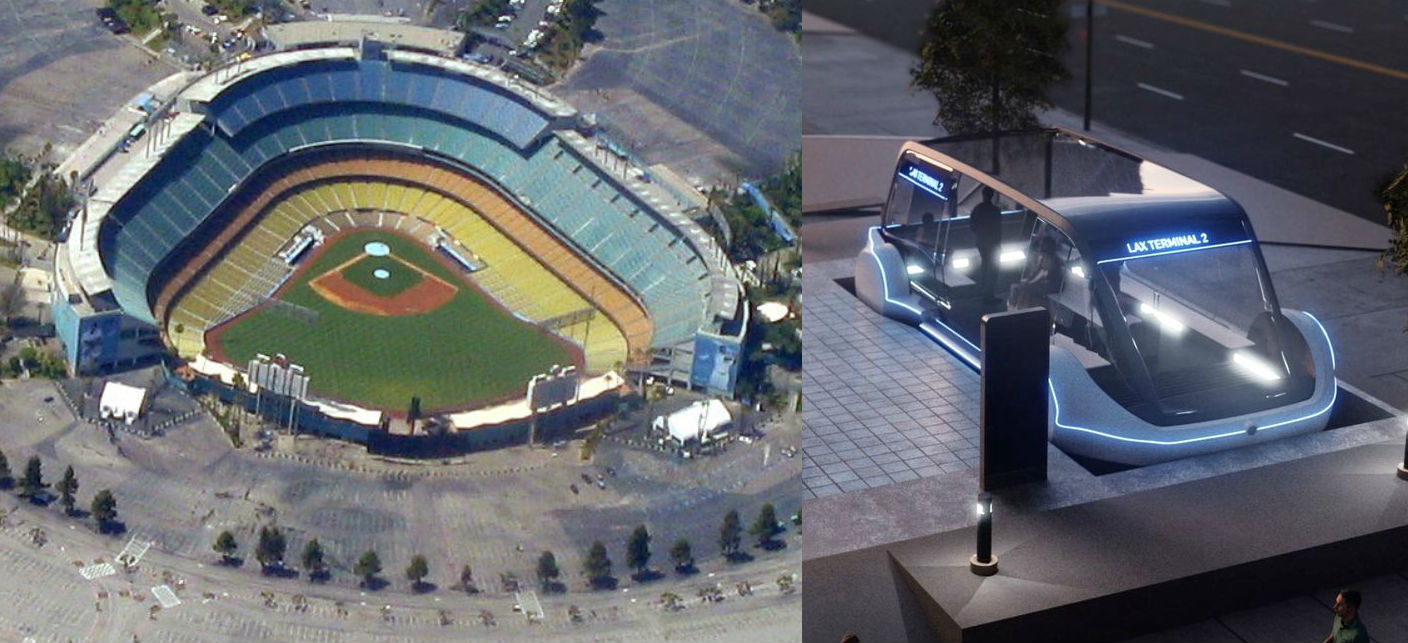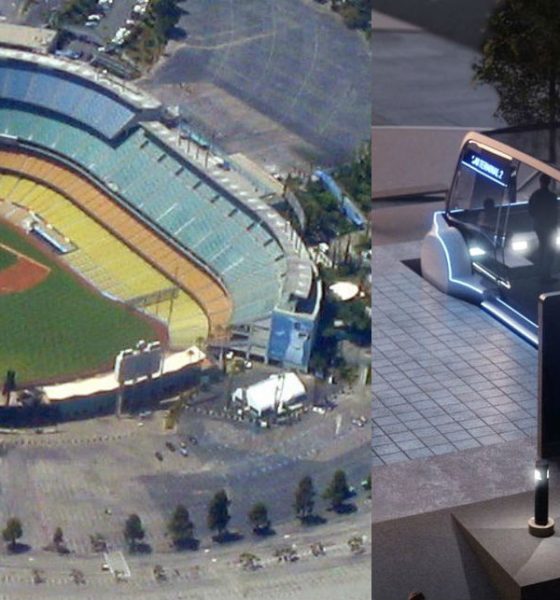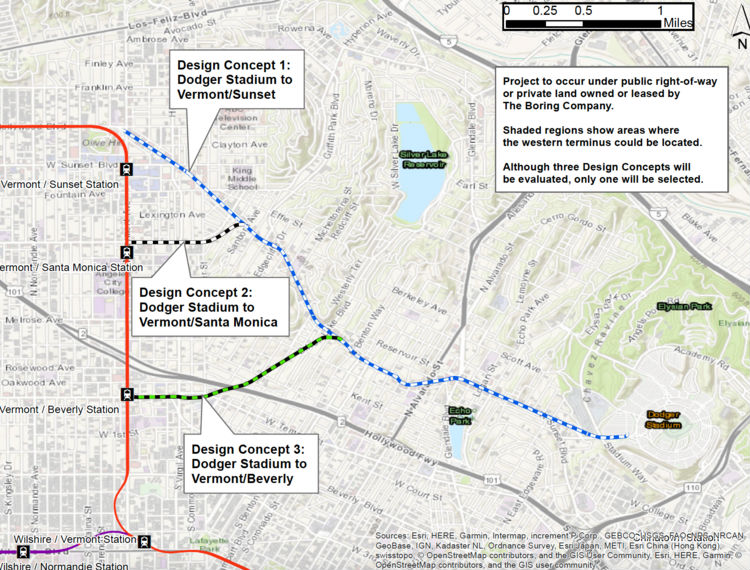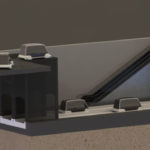

News
Elon Musk’s Boring Company proposes tunnel system leading to LA Dodgers Stadium
The Boring Company has unveiled a proposal to build a 3.6-mile tunnel system under Los Angeles designed to transport commuters to the Dodgers Stadium. Dubbed as the “Dugout Loop,” the tunneling startup’s project aims to transport people to the stadium in under 4 minutes.
The LA Dodgers Stadium is one of the city’s most prominent landmarks, where events such as games and concerts are held. The stadium in itself is massive, with a seating capacity of 56,000. Unfortunately for Los Angeles residents, getting to the Dodgers Stadium is nothing short of a traffic-inducing nightmare. During peak season, it is not rare to see vehicles being backed up for miles in seemingly unmoving traffic. This makes the travel time to the stadium, especially for commuters with their own cars, an unnecessarily long and aggravating affair.
This makes the LA Dugout Loop the perfect project for the Boring Company, a tunneling startup conceived by SpaceX and Tesla CEO Elon Musk due to his experiences in traffic. The Boring Company is currently involved in several projects, the most prominent of which is the downtown Chicago-O’Hare high-speed transport system, which is expected to break ground as soon as its permits are completed. A test tunnel under SpaceX’s headquarters in Hawthorne is also nearing completion.

The 3.6-mile Dugout Loop will begin at the Dodger Stadium property and run under Vin Scully Avenue and Sunset Boulevard. The Boring Company has not announced the starting point of the tunnel system, but there are currently three options being explored. All of these options — Vermont/Sunset, Vermont/Santa Monica or Vermont/Beverly — are selected specifically to be close to Metro Red Line stations.
The Los Angeles Bureau of Engineering (LABOE) has posted a document covering some of the finer details of Boring Company’s proposed project, including the design of the tunnels, how the electric pods in the Loop system will work, and the accessibility of the tunnels themselves. The document, which could be viewed in full here, notes that the Boring Company plans to use access shafts that would serve as tunnel access points for ventilation, emergency exit, and general access. These would be spaced approximately 0.5 miles apart, totaling about three to six locations located along the proposed Main Artery Tunnel alignment.
- The Boring Company’s eastern terminus configuration for the Dugout Loop. [Credit: The Boring Company]
- The Boring Company’s western terminus configuration for the Dugout Loop. [Credit: The Boring Company]
The transport pods would be stored in parking spaces, parking garages, or car racks at Loop Lift locations. Lastly, the LABOE document also mentioned that initially, commuters who wish to use the Dugout Loop would book timeslots online or on the phone in advance. Initial operations of the tunnel system would be limited to around 1,400 people, but depending on community feedback, the tunneling startup could increase ridership to about 2,800 people per event. The ability to purchase tickets for the Dugout Loop onsite is also on the table.
The Boring Company’s proposed tunnel to the Dodgers Stadium has gained the support of some of the city’s officials. In a statement to WIRED, LA Mayor Eric Garcetti described the project as a good example of the private and public sector working together.
“It’s a great example of public-private partnership. We always reimagine the future in Los Angeles. We’ve always looked for new ways to move around,” the LA mayor said.
Always exciting to see innovative ideas like the proposed Dugout Loop to @Dodgers Stadium that could help ease congestion on our roads and make our most iconic destinations more accessible to everyone. https://t.co/vleQtpUqnt
— Mayor Karen Bass (@MayorOfLA) August 16, 2018
Dodgers CFO Tucker Kain also expressed his support for the project, stating that the team is always supportive of novel ways to get fans to games in a more comfortable manner.
“We were excited when the Boring Company came to us with this project. Whether it is flying overhead in an aerial transit system or bypassing traffic through an underground tunnel, we are always looking for innovative ways to make it easier for Dodgers fans to get to a game. We are committed to working with our neighbors and fans as the project moves forward,” Kain said in a statement to ABC7.
Construction of the proposed tunnel project is estimated to take about 14 months to complete. The tunneling startup is making its proposal for the Dugout Loop available for public review from August 16 to September 17. A hearing will also be held at the Dodgers Stadium on August 28.

News
Tesla FSD fleet is nearing 7 billion total miles, including 2.5 billion city miles
As can be seen on Tesla’s official FSD webpage, vehicles equipped with the system have now navigated over 6.99 billion miles.

Tesla’s Full Self-Driving (Supervised) fleet is closing in on almost 7 billion total miles driven, as per data posted by the company on its official FSD webpage.
These figures hint at the massive scale of data fueling Tesla’s rapid FSD improvements, which have been quite notable as of late.
FSD mileage milestones
As can be seen on Tesla’s official FSD webpage, vehicles equipped with the system have now navigated over 6.99 billion miles. Tesla owner and avid FSD tester Whole Mars Catalog also shared a screenshot indicating that from the nearly 7 billion miles traveled by the FSD fleet, more than 2.5 billion miles were driven inside cities.
City miles are particularly valuable for complex urban scenarios like unprotected turns, pedestrian interactions, and traffic lights. This is also the difference-maker for FSD, as only complex solutions, such as Waymo’s self-driving taxis, operate similarly on inner-city streets. And even then, incidents such as the San Francisco blackouts have proven challenging for sensor-rich vehicles like Waymos.
Tesla’s data edge
Tesla has a number of advantages in the autonomous vehicle sector, one of which is the size of its fleet and the number of vehicles training FSD on real-world roads. Tesla’s nearly 7 billion FSD miles then allow the company to roll out updates that make its vehicles behave like they are being driven by experienced drivers, even if they are operating on their own.
So notable are Tesla’s improvements to FSD that NVIDIA Director of Robotics Jim Fan, after experiencing FSD v14, noted that the system is the first AI that passes what he described as a “Physical Turing Test.”
“Despite knowing exactly how robot learning works, I still find it magical watching the steering wheel turn by itself. First it feels surreal, next it becomes routine. Then, like the smartphone, taking it away actively hurts. This is how humanity gets rewired and glued to god-like technologies,” Fan wrote in a post on X.
News
Tesla starts showing how FSD will change lives in Europe
Local officials tested the system on narrow country roads and were impressed by FSD’s smooth, human-like driving, with some calling the service a game-changer for everyday life in areas that are far from urban centers.

Tesla has launched Europe’s first public shuttle service using Full Self-Driving (Supervised) in the rural Eifelkreis Bitburg-Prüm region of Germany, demonstrating how the technology can restore independence and mobility for people who struggle with limited transport options.
Local officials tested the system on narrow country roads and were impressed by FSD’s smooth, human-like driving, with some calling the service a game-changer for everyday life in areas that are far from urban centers.
Officials see real impact on rural residents
Arzfeld Mayor Johannes Kuhl and District Administrator Andreas Kruppert personally tested the Tesla shuttle service. This allowed them to see just how well FSD navigated winding lanes and rural roads confidently. Kruppert said, “Autonomous driving sounds like science fiction to many, but we simply see here that it works totally well in rural regions too.” Kuhl, for his part, also noted that FSD “feels like a very experienced driver.”
The pilot complements the area’s “Citizen Bus” program, which provides on-demand rides for elderly residents who can no longer drive themselves. Tesla Europe shared a video of a demonstration of the service, highlighting how FSD gives people their freedom back, even in places where public transport is not as prevalent.
What the Ministry for Economic Affairs and Transport says
Rhineland-Palatinate’s Minister Daniela Schmitt supported the project, praising the collaboration that made this “first of its kind in Europe” possible. As per the ministry, the rural rollout for the service shows FSD’s potential beyond major cities, and it delivers tangible benefits like grocery runs, doctor visits, and social connections for isolated residents.
“Reliable and flexible mobility is especially vital in rural areas. With the launch of a shuttle service using self-driving vehicles (FSD supervised) by Tesla in the Eifelkreis Bitburg-Prüm, an innovative pilot project is now getting underway that complements local community bus services. It is the first project of its kind in Europe.
“The result is a real gain for rural mobility: greater accessibility, more flexibility and tangible benefits for everyday life. A strong signal for innovation, cooperation and future-oriented mobility beyond urban centers,” the ministry wrote in a LinkedIn post.
News
Tesla China quietly posts Robotaxi-related job listing
Tesla China is currently seeking a Low Voltage Electrical Engineer to work on circuit board design for the company’s autonomous vehicles.

Tesla has posted a new job listing in Shanghai explicitly tied to its Robotaxi program, fueling speculation that the company is preparing to launch its dedicated autonomous ride-hailing service in China.
As noted in the listing, Tesla China is currently seeking a Low Voltage Electrical Engineer to work on circuit board design for the company’s autonomous vehicles.
Robotaxi-specific role
The listing, which was shared on social media platform X by industry watcher @tslaming, suggested that Tesla China is looking to fill the role urgently. The job listing itself specifically mentions that the person hired for the role will be working on the Low Voltage Hardware team, which would design the circuit boards that would serve as the nervous system of the Robotaxi.
Key tasks for the role, as indicated in the job listing, include collaboration with PCB layout, firmware, mechanical, program management, and validation teams, among other responsibilities. The role is based in Shanghai.
China Robotaxi launch
China represents a massive potential market for robotaxis, with its dense urban centers and supportive policies in select cities. Tesla has limited permission to roll out FSD in the country, though despite this, its vehicles have been hailed as among the best in the market when it comes to autonomous features. So far, at least, it appears that China supports Tesla’s FSD and Robotaxi rollout.
This was hinted at in November, when Tesla brought the Cybercab to the 8th China International Import Expo (CIIE) in Shanghai, marking the first time that the autonomous two-seater was brought to the Asia-Pacific region. The vehicle, despite not having a release date in China, received a significant amount of interest among the event’s attendees.










